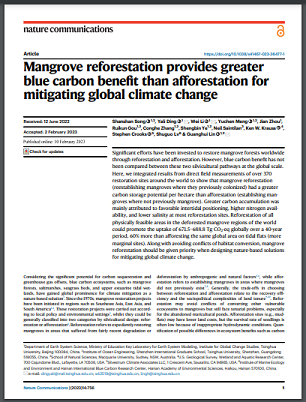
Significant efforts have been invested to restore mangrove forests worldwide through reforestation and afforestation. However, blue carbon benefit has not been compared between these two silvicultural pathways at the global scale. Here, we integrated results from direct field measurements of over 370 restoration sites around the world to show that mangrove reforestation (reestablishing mangroves where they previously colonized) had a greater carbon storage potential per hectare than afforestation (establishing mangroves where not previously mangrove). Greater carbon accumulation was mainly attributed to favorable intertidal positioning, higher nitrogen availability, and lower salinity at most reforestation sites. Reforestation of all physically feasible areas in the deforested mangrove regions of the world could promote the uptake of 671.5–688.8 Tg CO2-eq globally over a 40-year period, 60% more than afforesting the same global area on tidal flats (more marginal sites). Along with avoiding conflicts of habitat conversion, mangrove reforestation should be given priority when designing nature-based solutions for mitigating global climate change.














